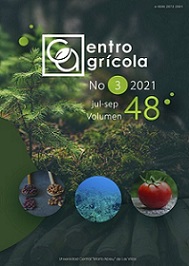SCIENTIFIC ARTICLE
Dry matter and primary macroelements on the foliar biomass of sugarcane with different fertilizer rates of potassium
Materia seca y macroelementos primarios en la biomasa foliar de la caña de azúcar fertilizada con diferentes dosis de potasio
Juan Alejandro Villazón Gómez1, George Martín Gutiérrez2, Yakelín Cobo Vidal2, Yunior Rodríguez Ortiz2 y Beatriz Montero Sarría2
1 Facultad de Ciencias Agropecuarias. Universidad de Holguín (UHO), Ave. XX Aniversario, vía Guardalavaca, Piedra Blanca, Holguín,Cuba. CP 80100.
2 Estación Provincial de Investigaciones de la Caña de Azúcar (EPICA). Guaro S/N, Mayarí, Holguín, Cuba. CP 83000.
E-mail: This email address is being protected from spambots. You need JavaScript enabled to view it.
ABSTRACT
The research consisted of determining the quantities of dry matter and primary macroelements on the foliar biomass that contributes to the soil the sugarcane fertilized with different fertilizer rates of potassium in an experiment with a design in complete blocks at random (8 treatments x 6 repetitions) on a Chromic Vertisol. Five plants were cut in the furrows 2 and 3 of the plots of the 3rd repetition before the harvest of each one of the four ratoons. To the sugarcane top of the samples were determined the percentages of dry matter, nitrogen, phosphorus and potassium; was carried out a count of sugarcane stalk in each plot to express the percentages in magnitudes of mass. An analysis of variance of simple classification was executed and means were compared by Duncan test at 95 % of confidence. The treatment V was the one of bigger dry matter content, with 11.04 t ha-1. The 2nd ratoon showed the bigger dry matter content in the sugarcane tops, with 11.13 t ha-1. In the interactions the bigger influence of the sugarcane stubble phase on the dry matter can be appreciated. The treatment V was the one of bigger nutrient content, with 83, 16 and 197 kg of NPK, respectively. In the case of nitrogen the best interaction was the treatment V in the 3rd ratoon, in the phosphorus also the treatment V in the 2nd and 3rd ratoons and the treatment IV in the 4th ratoon, in potassium the interaction of the treatment V in the 2nd ratoon.




